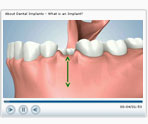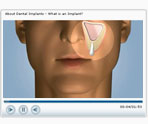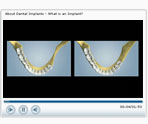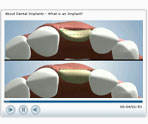Bone Augmentation
Not enough bone? If you have been told that you may not have enough bone for dental implants do not despair, The Implant Centre specialises in just your type of case.
There are various types of bone augmentation that are required in different situations, and if you need this we will explain to you why and how this is carried out. Not everyone needs this as part of their treatment, but where there is a lack of bone all of our surgeons are extremely well trained for this type of specialised procedure.
Guided Bone Augmentation
This is carried out at the time of
implant placement, and you will be unaware of the procedure apart from
taking a few more minutes of surgery time. Bone is added around the
implant due to small deficiencies in your own bone. This will help to
maintain the look of the implant crown where it comes out of the gum.
There are various material options to use for this technique, and we have chosen our favoured materials following careful research. We will explain what the material is and why it should be used in the cases required. Some of the materials used have animal derivatives – however if you would like us to use man made alternatives we will be pleased to offer this.
Sinus Grafting
The bones that make up your face are hollow and contain air spaces known as sinuses. The sinuses that sit above your upper back teeth are known as the maxillary sinuses.
When an upper posterior tooth is lost, the floor of the maxillary sinus drops down into the space formerly occupied by the root of the lost tooth. In order to place an implant, it is often necessary to put the sinus floor back up to where it originally was by adding a bone substitute. This procedure is called a sinus floor bone augmentation or a sinus lift.
Block Graft Materials
The most widely-used material for grafting in implants is a very safe material called Bio-Oss and it is derived from cow-bone. It has been specifically treated to remove all of the protein from the graft material so there is absolutely no risk of developing mad-cow disease or foot-and-mouth. It has been used for over 20 years without any problems and it is our graft material of choice in most situations. You can find out more about this material at
www.osteohealth.com/Bio-Oss.html
It is often necessary to contain the graft material using a membrane (just as a bucket will help to hold sand in the shape of a sandcastle). Some membranes are dissolvable and therefore do not need to be removed at a later stage and these are the ones that we use whenever possible. The most widely used dissolvable membrane in the world is made from collagen taken from pigs and is extremely safe. To find out more please go to http://www.osteohealth.com/Bio-Gide.html
Occasionally there are good reasons why we may choose a different material for your graft or membrane and we would explain these to you. Alternatively, you may have a strong preference for us to use one material over another and if so, you should let us know well in advance.
Block Grafts
When a lot of bone has been lost from the front part of the upper jaw, it is occasionally necessary to build this back using a block of bone from the patient – in exactly the same way that bricks are used to build a wall. This bone is usually taken from the back of the lower jaw though sometimes it may instead be taken from the chin. This block of bone is securely attached to the deficient ridge using tiny titanium bone-screws and will allow dental implants to be placed once the block graft has healed.
Call 01444 474 015 for more information




